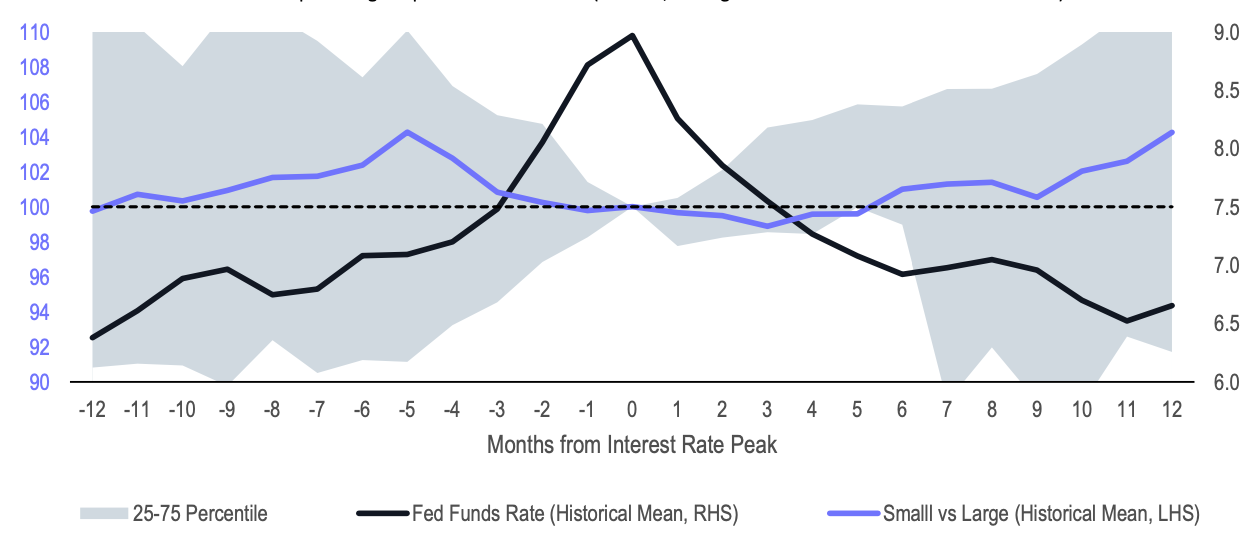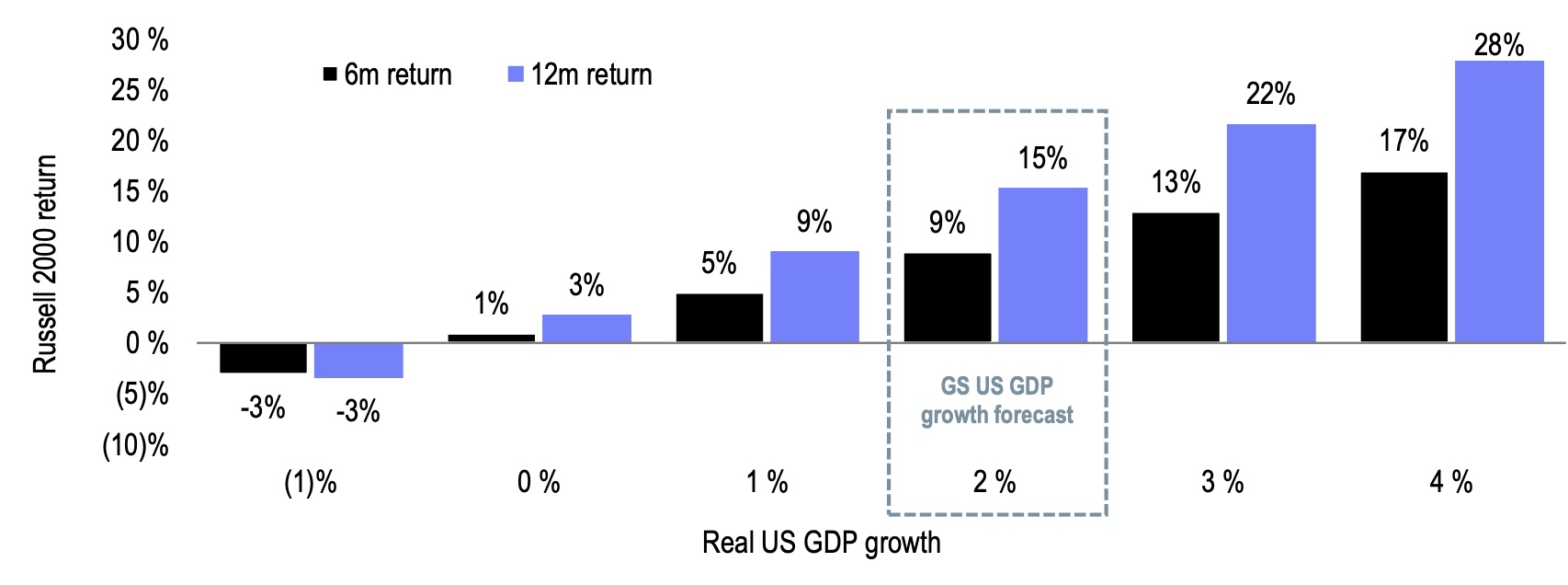The appeal of global small caps extends well beyond valuations
Historically, small-cap equities have outperformed large-cap equities in the early stages of the economic cycle under macroeconomic recovery and acceleration conditions.
After more than a year of elevated volatility, cooling inflation and the prospect of rate cuts in 2024 suggests an early expansion backdrop, akin to historically favourable conditions for small caps.
While individual small-cap companies exhibit a high level of volatility, the performance of small caps as an asset class can serve as an essential complement to core investor allocations in this current market environment.
Outperformance post interest rate peaks
After one of the fastest rate hiking cycles in history, there is now a consensus that rate cuts will occur in 2024, although some uncertainty remains regarding exactly when and by how many rates will be cut this year. In general, falling interest rates have benefitted equities, given the associated lowering of the cost of capital serves as a boon to companies’ profitability.
Furthermore, in relative terms, small-cap equities have historically outperformed large caps in the year after an interest rate peak, on average by 4.3%.
Notably, average outperformance in the 12 months after a rate peak holds regardless of the accompanying growth environment – whether the US witnessed a recessionary period or not in those months.

Source: Kenneth R. French, Federal Reserve Bank of St. Louis, and Goldman Sachs Asset Management. As of 29 December, 2023. Interest rate levels refer to the Fed Funds rate. “US Small vs Large” refers to Fama & French’s SMB factor. The 19 months of peak interest rates identified are in October 1957, October 1959, November 1966, May 1968, September 1969, August 1971, September 1973, July 1974, April 1980, January 1981, June 1981, April 1982, August 1984, March 1989, April 1995, July 2000, July 2007, April 2019, and July 2021. Past performance does not guarantee future results, which may vary.
Small vs large caps ROE per valuation level
Because small-cap valuations have remained historically low while fundamentals have gradually improved, their potential returns relative to valuations are at some of their highest historical levels.
Analysing the ROE ratio between the MSCI World Small Cap and the MSCI World, it is noteworthy that 2023 figures lie among the highest, while valuations are within the lowest since 2017. As a result, the ratio between the ROE to valuation lies above the five-year average.

Source: Goldman Sachs Asset Management and MSCI. As of 31st December 2023. Small vs Large Refers to the ratio of MSCI World Small Cap to MSCI World, ROE and PE figures respectively.
Challenges for small caps in the recent rising rate environment, coupled with economic growth concerns and macroeconomic conditions, have created a temporary dislocation in historical patterns. This dislocation has pushed small cap valuations down to their lowest quartile since 2006. As of 31 December 2023, the MSCI World Small Cap Index trades on par with the MSCI World Index, representing a 19% discount from the historical average and a 44% discount from the peak in 2020 (see below).

Similarly, considering the absolute valuations of the small-cap complex, we also observe a discount relative to history. As of December 2023, the price-to-earnings estimates forward 12 months (P/E NTM) for the MSCI World Small Cap Index were 5% lower than the historical average, representing a 59% discount from the latest peak in 2020.
How small-cap companies may benefit from debt structures
Questions around debt servicing and refinancing lie at the core of company performance during interest rate peaks. Smaller companies typically have shorter refinancing cycles and higher proportions of floating-rate debt. Due to their increased risk profiles, they often need to turn to higher-yield debt with shorter maturities.
While this characteristic of smaller companies may be concerning during rising interest rate environments, during the converse, it could serve as an interesting tailwind for performance.
The economic growth outlook
Goldman Sachs Economics forecasts 2024 real US GDP growth of 2%, while Bloomberg consensus estimates remain positive at 1.6%, with recent outperformance of cyclical industries suggesting that the US equity market is pricing a US economic growth environment modestly even above Goldman Sachs’ forecasts. Notably, in periods with these growth estimate levels (1-2%), global small caps have, on average, been able to outperform large caps when interest rates fall.
Looking forward, in the case of a growth outcome weaker than expected, while it could be challenging for small caps to outperform large caps, the return outlook at an absolute level remains positive as current valuations provide an important buffer against the potential downside.
For example, focusing on the US market, Goldman Sachs Global Investment Research’s return forecasts stand in positive territory as long as growth does, suggesting growth would have to deteriorate substantially from current estimates for the model to signal losses for the Russell 2000 (see below).
Modelled forward Russell 2000 returns conditional on coincident US GDP growth (January 2024 estimates)

Source: Goldman Sachs Global Investment Research. As of January 2024.
How to invest in small caps?
The small cap investment universe continues to be one of the most vibrant and exciting parts of the market in which to invest. This universe continues to expand and is constantly refreshed through the creation of new companies, IPOs and other corporate activities such as M&A and spinoffs.
With a typical turnover of around five times higher than the large-cap universe, this creates an environment with an evergreen source of broad and persistent alpha worth evaluating through an active management approach that can also effectively manage the associated risks.
As of 31 December 2023, small-cap universes are approximately three to five times larger than their large-cap counterparts, with the investable universe of MSCI World Small Cap being almost three times larger than that of the MSCI World’s. This breadth is spread across all sectors and industries.
Some of the most notable differences in the available scale of the global opportunity small cap companies, compared with large cap companies across different sectors, are shown in the following table.
Vibrance of large-cap universe facilitated by market breadth

Past performance does not predict future returns and does not guarantee future results, which may vary. Source: MSCI and Goldman Sachs Asset Management. As of 31 Dec 2023. There is no guarantee that objectives will be met. This is a marketing communication. Please refer to the Prospectus of the Fund/s and the KIID/s before making any final investment decisions. The portfolio risk management process includes an effort to monitor and manage risk but does not imply low risk. Diversification does not protect an investor from market risk and does not ensure a profit
Conclusion
In 2024, the combination of low current valuations and evolving macroeconomic dynamics could be the base for a strong comeback of the small cap complex. Looming interest rate cuts position the more floating rate-indebted small caps to reap disproportionate benefits, having historically proved resilient amid lowering interest rate environments. Despite improving fundamentals, current valuations remain at historical lows, suggesting now could be a pivotal entry point to the small cap complex.
Given the large, diversified, and under-researched nature of the small cap universe, we believe that the breadth of the small cap complex and the presence of informational inefficiencies create a unique opportunity for quantitative managers to leverage big data, engage in effective stock selection, and deliver consistent outperformance for investors.
For more information on the Yarra Global Small Companies Fund, please click below:

3 topics
1 fund mentioned

